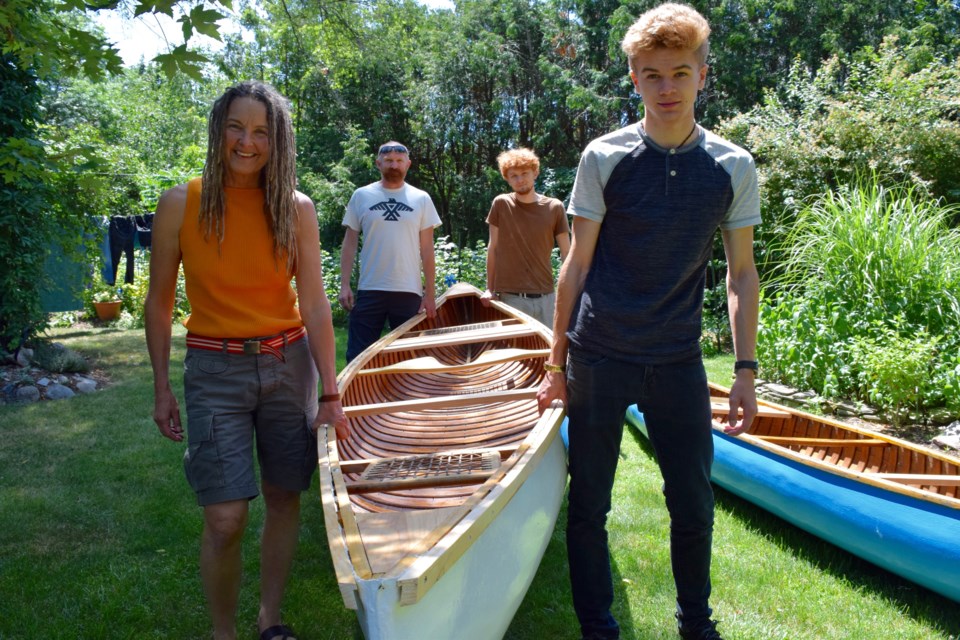Here’s what can be done, if you dare to dream, and have a strong paddling stroke. Guelph’s Jeremy Shute and members of his family are getting ready to do it.
Realistically, a canoe can be placed in the Speed River just at the Covered Bridge in the downtown area of Guelph. From there, a paddler can push off and follow the gentle current of the Speed River west, then a bit south, until it meets the Grand River.
Paddling that larger river due south will get you all the way to Lake Erie. Take a hard left there and hug the shore, and numerous other shores, and in under 100 days you can reach the Atlantic Ocean.
That about summarizes the proposed paddling route Shute, his wife Leslie Howarth, and a shifting crew of their three children will take starting Saturday, making their way by stages to the east coast by canoe. Their journey is being called Speed to Sea.
The family has spent months in preparation. Two classic canoes have been rebuilt and reinforced for the expedition, and Shute’s mother has sown a pair of spray skirts for them. The paddlers expect waves. One of the canoes is sail ready.
There will be many route-related decisions to make along the way, a big one being which shore of the St. Lawrence River to hug once they pass Quebec City. The family has done many big lake and wilderness canoe expeditions, and a few years ago took half a year to make an epic family journey around the world. Children Emma, Kofi, and Nigel have been on many adventures in their young lives.
The paddle to the sea is being done for the sake of adventure, but also to fill two classic cedar and canvas canoes, at least figuratively, with stories gathered from people along the route.
Part of the inspiration behind it, Shute said in an interview, is the classic Canadian book and film, Paddle to the Sea, about a carved toy canoe that is released into a stream and carried to the Atlantic. Watch the National Film Board of Canada film here.
“You keep Lake Erie’s shore on your left, and when you get to the Niagara River, you turn left again, where there’s a portage around a particularly tremendous set of rapids,” said Shute, 50, speaking fast water leading into Niagara Falls. He added in jest that he’s fairly certain those rapids can not be run in a canoe at this time of the year, at least not without a set of wings. The portage around the falls is about 15 kilometers long.
Shute has an in-depth knowledge and a longstanding fascination with river systems, and was the chair of the City of Guelph’s river systems advisory committee for many years. He is the man who mapped Guelph’s buried streams.
Shute is a partner in the consulting firm Shared Value Solutions, which works primarily with Indigenous communities across Canada related to large developments projects. He’s taken holidays for the first stretch of the journey.
“There is the whole idea of being a part of a watershed, part of this greater system – that if you just keep going downstream you’ll eventually end up in the ocean,” he said. “We are really kind of all connected through that system. So, it is just the idea of going downstream, and just go and go and go as far as you can go. It seems like it’s worth giving it a try.”
There is a Facebook page and an Instagram site set up to chronicle the journey.
The trip should take a total of 80 to 90 days of paddling, depending on all the many variables. Rigging a sail to the canoes may help rest tired paddling arms and cut down on time. Wind and waves will certainly be a factor. The trip is being done in sections – some in the summer, others in the fall, and more next year.
“I do a lot of work with video and audio,” Shute said. “I’m going to try to record a bunch of the trip, and also record people’s stories as we go – gather and share their stories, maybe about their connection to the waterway, and the cool things they’re doing in their life to make the world around them better.”
His aim, he added, is to “have an empty boat at the beginning, and to fill it with stories as I go down stream.”
The explorers could use some community support along the way, particularly from those living along the paddling route who could offer accommodations, even if it is just a backyard for pitching tents. Other paddlers are welcome to join in the journey at any stage.
